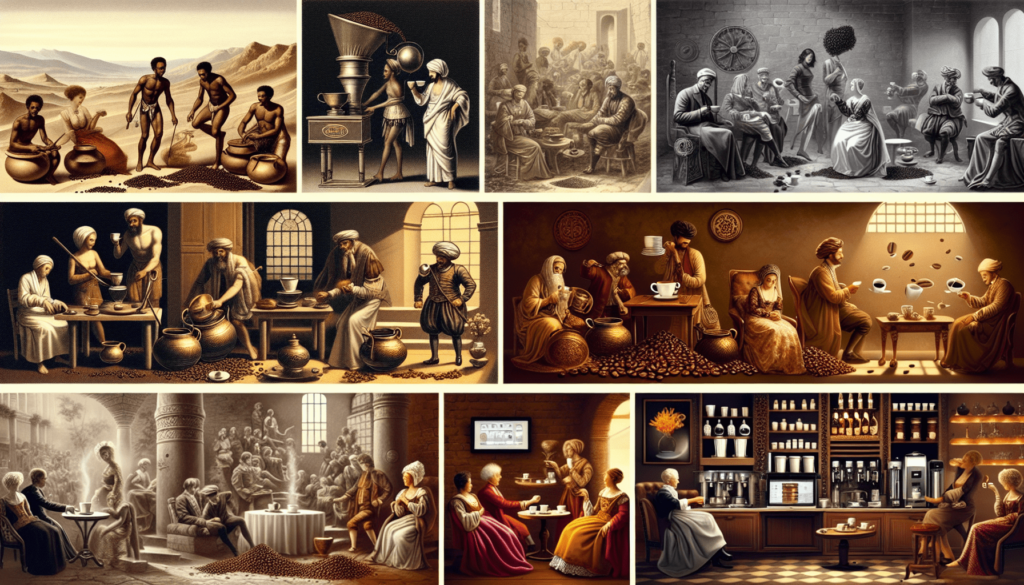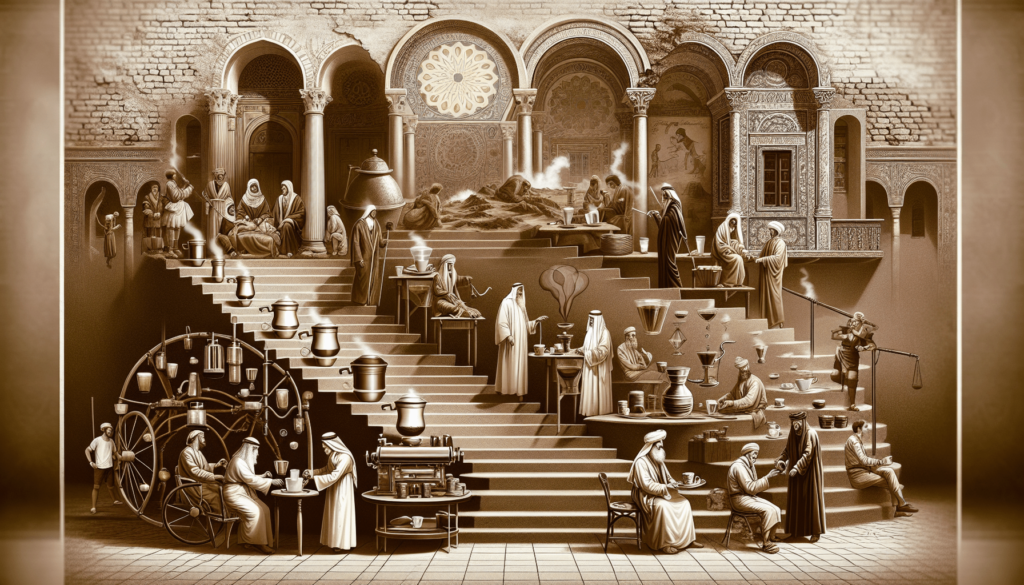Have you ever pondered the subtle differences between a coffee and a latte, and how each delivers a unique experience to the senses? If so, you’re not alone. The world of coffee is vast, rich, and layered, much like the flavors in a well-crafted cup.
Coffee Chronicles

The Origins of Coffee
Coffee’s journey begins in the Ethiopian highlands, where legend has it that a goat herder named Kaldi discovered its powers. His goats, after feasting on bright red berries, became spirited and full of energy. Intrigued, Kaldi sampled the berries himself and soon felt a similar burst of vitality. This discovery was shared with local monks, who used the berries to stay awake during long hours of prayer. Thus, coffee as we know it began its ascent from humble origins.
The Evolution of Coffee
Over centuries, coffee traveled through the Middle East, Northern Africa, and Europe. It became a valued commodity, second only to oil. Each region adopted and adapted coffee to its culture, resulting in a plethora of brewing methods and rituals. From the Turkish cezve brewing method to the Italian espresso, the diversity in coffee preparation reflects its historical and cultural migration.
Coffee vs Latte: The Basics
To fully appreciate the distinctions between coffee and a latte, you first need to understand what each one is.
| Drink | Ingredients | Preparation Method |
|---|---|---|
| Coffee | Ground coffee, hot water | Brewed through various methods |
| Latte | Espresso, steamed milk, foam | Specialty espresso machine required |
Coffee
Coffee is typically brewed from ground coffee beans and hot water. The method of brewing, whether it’s drip, French press, or espresso, significantly affects the flavor and character of the beverage. When you drink a cup of coffee, you’re tasting the purest essence of the coffee bean.
Latte
A latte, on the other hand, involves more complexity. It’s built with a base of one or two shots of espresso, which provides a strong and rich flavor. Steamed milk is then poured over the espresso, creating a creamy texture, and a thin layer of milk foam is added on top. The result is a balanced, rich, and smooth drink that tempers the intensity of the espresso with the softness of steamed milk.
Different Brewing Methods
Drip Coffee
Drip coffee is a common method where hot water passes through ground coffee beans contained in a filter. This is a straightforward and convenient way to brew coffee, making it popular in many households and offices.
French Press
French press, or press pot, offers a more hands-on approach. Ground coffee is steeped in boiling water for several minutes before being pressed through a metal or cloth filter. This method yields a thicker, more robust coffee.
Espresso
Espresso, the heart of many specialty drinks, is made by forcing hot water under pressure through finely-ground coffee. This method produces a small, concentrated shot of coffee rich in flavor and intensity.
The Coffee Bean Spectrum
Coffee beans are central to the ultimate taste of your coffee or latte, and the two primary types are Arabica and Robusta.
Arabica
Arabica beans are high-quality and nuanced in flavor, often featuring a spectrum of fruity, floral notes. They are grown in high-altitude regions and are considered superior in the coffee world.
Robusta
Robusta beans, while stronger in caffeine, generally possess a harsher and more bitter flavor. They are easier to cultivate and are often used in espresso blends for their robusto kick.
Specialty vs. Commercial Coffee
The debate between specialty and commercial coffee is a testament to the evolving appreciation for coffee quality and craftsmanship.
Specialty Coffee
Specialty coffee refers to high-quality coffee beans that are meticulously sourced and roasted to highlight their unique flavors. It’s akin to fine wine, where the emphasis is on the nuances and complexities of each cup.
Commercial Coffee
Commercial coffee is mass-produced, focusing on consistency and affordability rather than unique flavor profiles. The beans are often roasted to a darker level to maintain a uniform taste regardless of the origin.
Latte Art and its Cult Following
A latte isn’t just a drink; it’s a canvas. The art of pouring steamed milk into espresso to form patterns on the surface has led to a cult following.
Popular Latte Art Designs
Common designs include hearts, rosettas, and tulips. For the more advanced baristas, intricate designs like swans and detailed portraits are the ultimate challenge.
The Importance of Milk
Milk plays an essential role in a latte. The type, temperature, and frothing technique can drastically impact the texture and flavor of the drink.
Whole Milk
Whole milk is prized for its creaminess and ability to create a rich, velvety texture.
Alternative Milks
Soy, almond, oat, and other plant-based milks each bring unique flavors and textures to a latte, catering to various dietary preferences and taste buds.
The Latte Variations
Over time, the term ‘latte’ has broadened to encompass various milk-based espresso drinks, each offering a different take on the classic.
Cappuccino
A cappuccino is similar to a latte but features equal parts of espresso, steamed milk, and foam. It provides a stronger espresso flavor with a rich, velvety texture from the foam.
Flat White
A flat white consists of espresso and steamed milk, with little to no foam. It originated in Australia and New Zealand and showcases a stronger coffee-to-milk ratio than a latte.
The Role of Sweeteners and Flavors
Plain vs. Flavored
The debate between plain and flavored coffee and lattes is all about personal preference. While purists may opt for the unadulterated taste of coffee, others enjoy the additional flavors of syrups and spices.
Common Add-Ins
Common add-ins include vanilla, caramel, and hazelnut syrups. Seasonal flavors like pumpkin spice or peppermint also make appearances, particularly around holidays.
Coffee Shop Culture
Coffee shops have become cultural hubs, offering more than just a caffeine fix. They provide a space for social interaction, remote work, and relaxation.

Specialty Coffee Shops
Specialty coffee shops prioritize the quality of their coffee. You might pay more, but you’re paying for ethically sourced, high-quality beans and the expertise of a skilled barista.
Chain Coffee Shops
Chain coffee shops offer convenience and consistency. While the coffee might not rival specialty shops, you know what you’re getting regardless of the location.
The Home Brewing Movement
The appeal of brewing coffee at home has surged, thanks to advancements in quality and accessibility of home brewing equipment.
Equipment Essentials
Basic equipment like grinders, scales, and quality coffee makers can substantially improve your home brewing experience.
Popular Home Brewing Devices
| Device | Type | Benefits |
|---|---|---|
| French Press | Immersion | Rich, full-bodied coffee |
| AeroPress | Pressure-based | Versatile, portable, and easy to clean |
| Pour-over | Manual Drip | Control over brewing variables, clean taste |
| Espresso Machine | Pressure-based | Creates authentic espresso for lattes and cappuccinos |
Coffee Sustainability
The growing demand for coffee has raised sustainability concerns that conscientious consumers need to be aware of.
Fair Trade
Fair trade coffee ensures that farmers receive fair compensation for their produce, improving their living conditions and fostering sustainable practices.
Organic Coffee
Organic coffee eschews synthetic fertilizers and pesticides, promoting healthier ecosystems and safer working conditions for farmworkers.
The Health Impact of Coffee
Coffee offers a range of health benefits, provided it’s consumed in moderation.
Antioxidants
Coffee is a potent source of antioxidants, which help combat oxidative stress and inflammation in the body.
Mental Alertness
The caffeine in coffee enhances alertness and concentration, making it a popular choice for those needing a mental boost.
Risks of Overconsumption
Excessive coffee consumption can lead to jitteriness, insomnia, and other health issues. It’s essential to find a balance that works for you.
Coffee in Popular Culture
Coffee has entrenched itself in various aspects of popular culture, from TV shows to literary works.
Coffee in TV and Film
From the Central Perk in Friends to the Double R Diner in Twin Peaks, coffee shops provide a relatable and comforting setting in many TV shows and films.
Literary References
Authors have long celebrated coffee in their works, using it as a symbol of sophistication, contemplation, and social interaction.
The Coffee Experience
At its core, the appeal of coffee transcends the physical drink; it’s about the experience, the ritual, and the community that forms around it.
The Solo Experience
Enjoying a cup of coffee alone allows for a moment of reflection and personal enjoyment. It’s a time to savor the complex flavors and appreciate the craftsmanship involved.
The Social Experience
Sharing a coffee with friends or colleagues fosters a sense of camaraderie and connection. Coffee shops often serve as communal spaces where people come together to chat, work, or simply enjoy each other’s company.
Conclusion
Whether you lean towards a simple, robust coffee or a creamy, comforting latte, your choice reflects a personal journey through the diverse world of coffee. Each cup tells a story of its origins, preparation, and the moments it enhances. So, take a moment to appreciate your next brew, and let its flavors transport you through time and culture.
In the grand tapestry of coffee chronicles, every sip is a new chapter waiting to be savored.
